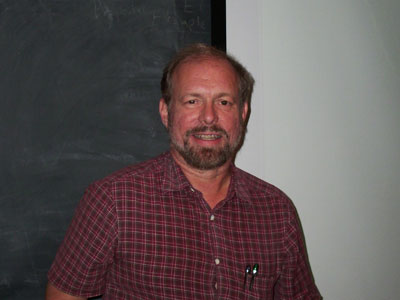Visiting scholar Dr. Joseph Fehribach, usually of Worcester Polytechnic Institute, made clear the nuances and importance of Kirchhoff graphs in his MCS colloquium “Matrices and their Kirchhoff graphs.”
Fehribach began by making sure his audience of mathematicians had a clear understanding of the material to be discuss. He first put a “not quite randomly” chosen matrix in his presentation to provide a numerical example and posed the question, “What graph fundamentally represents this matrix?” He demonstrated pictorially what a Kirchhoff graph was before progressing to a verbal definition of Kirchhoff graph, “Given a matrix N by M with integer elements… a directed geometric cyclic multigraph G is a Kirchhoff graph for A [the matrix] if and only if it satisfies two condition. The first is that u, a… vector, lies in the null space of A if and only if there is a cycle in G where you have u1… entries of s1, u2 of s2 and so on all the way through m. And the second condition is that vertex condition. It says that every vertex must lie in the row space.” Fehribach also made the audience aware of certain ideas, namely that he was, “Not saying the Kirchhoff graph is unique, but the row space and null space is certainly unique” and that not every directed geometric cyclic graph is in fact a Kirchhoff graph. Having provided his audience a firm basis in the topic, the lecture progressed to more theoretical ideas.
As he moved to deeper discussion of Kirchhoff graphs, Fehribach entered more unknown territory. He began the second portion of his lecture by stating, “Here’s a little conjecture: Every matrix over the rationals… has a Kirchhoff graph.” He continued on more personally, “This is the open question that I think is most interesting, and I think the answer is yes… but I have not been able to prove it.” Having established the issue, Fehribach moved to a different aspect, the construction of Kirchhoff graphs. Although this portion was quite interesting and somewhat foundational to the remainder of the lecture, it is extremely difficult to reproduce concisely. Thus, it shall not be discussed further.
Fehribach continued on to the practical applications of Kirchhoff graphs by discussing their ability to model reaction networks in chemical engineering. He chose to demonstrate on a simple hydrogen evolution reaction how the progression of chemicals can be reproduced by using vectors and Kirchhoff graphs. As this segment closely resembled the construction segment, it is also difficult to concisely reproduce. The most specific and important aspect was Fehribach’s response when asked what this was used for in chemical engineering. As he explained, “Suppose you want to know the rate of the overall reaction. That rate can be determined by a combination of rates of the individual steps.” Overall, the application of Kirchhoff graphs to chemical engineering was shown to be an advantage.
Though they can be considered a difficult concept to understand and their name may be extremely difficult to spell, Fehribach’s lecture made Kirchhoff graphs and their applications clear.



'Dr. Joseph Fehribach explains Kirchhoff' has no comments
Be the first to comment this post!